AP State Syllabus AP Board 6th Class Science Important Questions Chapter 11 Shadows – Images
AP State Syllabus 6th Class Science Important Questions 11th Lesson Shadows – Images
6th Class Science 11th Lesson Shadows – Images 2 Mark Important Questions and Answers
Question 1.
What is the need of light?
Answer:
We need light to see objects.
Question 2.
What is light of source?
Answer:
Substance which gives light is known as a source of light.
Question 3.
When the shadows are formed?
Answer:
Shadows are formed when opaque objects obstruct the path of light.
![]()
Question 4.
What we need to obtain shadow?
Answer:
In addition to light and object we also need a screen to obtain the shadow of an opaque object.
Question 5.
Are you guess the colour of object by its shadow?
Answer:
The colour of objects cannot be determined by looking at their shadows.
Question 6.
How the light travels?
Answer:
Light travels in a straight line.
Question 7.
When the light reflected?
Answer:
Light gets reflected when it falls on any object.
Question 8.
How do the people know that light travels in a straight line?
Answer:
People came to an understanding that light travels in a straight line by observing the shapes of shadows.
Question 9.
Why am I not able to see the objects clearly when it gets dark?
Answer:
In the dark light is not sufficient to see the objects.
Question 10.
Why am I not able to see the objects when the power goes off?
Answer:
When the power goes off light is absent. So we can’t see the objects.
Question 11.
How are we able to see the objects in the presence of light?
Answer:
The light reflects eyes that fell on objects. So we are able to see the objects.
![]()
Question 12.
Why are we not able to see the objects in the absence of light?
Answer:
Light is the source of visible since. So without light, we can’t see anything.
Question 13.
What are the conditions to form a shadow?
Answer:
We need a source of light and an opaque object and a screen to get a shadow.
Question 14.
How in ancient days, people came to an understanding that light travels in a straight line?
Answer:
In ancient days, by observing the shapes of shadows people came to an understanding that light travels in a straight line.
6th Class Science 11th Lesson Shadows – Images 4 Mark Important Questions and Answers
Question 1.
How can we see the objects?
Answer:
- When we put on the bulb, light falls on the object, bounces from the object and reaches us.
- We can see an object only when light falls on it and bounces back to our eyes.
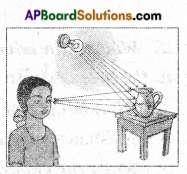
- The object is visible when there is no obstruction between your eyes and the object.
- It means light travels in straight lines.
Question 2.
How do you classify the objects according to light traveling through them?
Answer:
- The substances like paper, plank, wood, iron, etc. don’t allow light to pass through them. These objects form shadows. These are called opaque substances.
- The substances like glass and air allow light to pass through them and hence we don’t get their shadows. Such substances are called transparent substances.
- The substances such as polyethylene cover and oily paper partially allow the light to pass through them. Their shadows are unclear. These substances.
![]()
Question 3.
Write about shadow puppet?
Answer:
- Shadow puppetry is one of our traditional recreational activities.
- In this, some puppets are used to form shadows on a screen and a story is narrated with the help of these shadows.
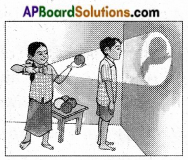
- By using this art old epics like Ramayana and Maha Bharat were played.
- Now a days this old art losses its glow.
Question 4.
Write the difference between opaque and transperent substances?
Answer:
Opaque: An object which does not allow light to pass through it and you are not able to see the objects behind your opaque material.
Transparent: An object that allows light to pass through it and you can see the objects behind your transparent material.
Question 5.
Vivek said that light and object are enough to form a shadow? Are you agree with him?
Answer:
No. I can’t agree with this statement. I understand that only light and an opaque object are not enough to form the shadow of an object. In addition to these, we need a screen.
Question 6.
Can we guess the object by observing its shadow?
Answer:
- Mostly we guess the object by observing its shadow.
- But it is not always possible.
- Sometimes the shadow may differ from the shape of the object.
- Because of light source position and shape of the object.
Question 7.
What is a pinhole camera?
Answer:
It is a small instrument that works on the light.
With this camera, we can observe a big object through a pinhole.
On the screen, it forms a little reverse image without a lance.
The nature of the straight-line motion of light can also be understood by this one.
Question 8.
Look at a tree through the pinhole camera. What do you see?
Answer:
When I observe the tree in the pinhole camera
- the image is small.
- it is inverted on the screen.
- it is colorful.
- and appear near to me.
![]()
Question 9.
Predict what would happen if we make two pin-holes in the camera?
Answer:
- If we make two pin-holes in the camera I predict that images are not clear.
- But it is a wonder that it forms two images, both are clear.
Question 10.
We see our faces in the mirror every day. Is the picture in the mirror a shadow or an image? How did you decide that?
Answer:
- The picture in the mirror is an image.
- We know that shadows are not colored but an image has colors that are the same as that of the object.
- A shadow shows only the outline of the object but an image shows the complete object as it is, just like a photograph.
- The picture in the mirror has color and shows a complete object. So its an imaged
Question 11.
Can you show the difference between a shadow and an image through a drawing?
Answer:
Yes, we can show the difference between shadows and images through a drawing.
- In images, we can use color and draw the whole picture.
- Whereas in shadows we draw only outline and fill with black.
6th Class Science 11th Lesson Shadows – Images 8 Mark Important Questions and Answers
Question 1.
How do you prove that screen is necessary to form shadow?
Answer:
Aim: To prove that screen is necessary to form shadow.
Materials: Torch, leaf, darkroom, drawing sheet, or plank.
Procedure:
- Do this activity in a dark room with a torch and a leaf.
- Focus the light on the leaf with a torch.
- Keep the distance about 30 cm between the leaf and the torch.

- Now the shadow is formed in the wall.
- Now put the torch under the leaf at a distance of about 30cm.
- Now the shadow is formed on the roof.
- Do the same activity, in the open air (outside) at night.
- Now we can’t find any shadow outside.

- Place a drawing sheet or a plank at a distance of 1 m. above
- Now we can find a shadow on the drawing sheet.
- It means the screen is needed to form shadows.
Conclusion: It is proved that screen is needed to form shadows.
![]()
Question 2.
Write the process of making a pinhole camera? (Activity – 6)
Answer:
Aim: Making a pin-hole camera.
Materials: A PVC pipe, about 8 cm in diameter and of length 30 cm.
A PVC pipe, about 7 cm in diameter and of length 20 cm.
One black drawing sheet. Oil -1 ml, two rubber bands, a pin, and A4 Sheet. (If you cannot get PVC pipes, take a thick sheet of paper and roll it to form tubes. The diameter and length of the tubes should be the same as that given for the pipes.)
Procedure:
- Cut a piece of black paper and put it like a cap at one end of the big pvc pipe and fix it with a rubber band as shown in the figure.
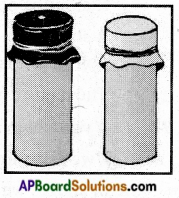
- Put the white paper like a cap at one end of the thinner PVC pipe.
- Fix it with a rubber band, now make a hole in the middle of the black paper cap with the help of a pin.
- Put 2 to 3 drops of oil on the white paper cap so that it becomes translucent.
- Insert the thin pipe into the big pipe. Your pinhole camera is ready
Working:
- Arrange a lighted candle in front of the pinhole of the camera.
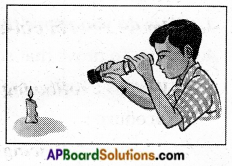
- Move the thinner pipe forward and backward to get a clear picture of the candle on the screen of the thin pipe.
- This picture is to be observed from the back of the thin pipe.
Observation: The flame of the candle appears inverted on the screen. This is not the shadow of the candle. It is its image.
![]()
Question 3.
Why the image in the pinhole camera is inverted?
Answer:
- The light from the candle travels straight in all directions from each point of the flame of the candle.
- But only the light coming in some particular directions can enter into the camera through its pin-hole.
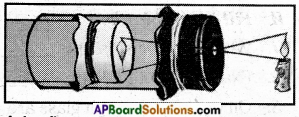
- The light that comes from the point at the top of the flame goes straight towards the bottom of the screen.
- And the light that comes from the point at the bottom of the flame goes straight towards the top of the screen.
- In this way, the light coming in a particular direction from each point of the flame will be able to enter into the pin-hole.
- And light going in other directions is blocked by the black sheet.
- This leads to the formation of an inverted image.
- The formation of an inverted image on the screen of the pinhole camera explains that light travels in a straight line.